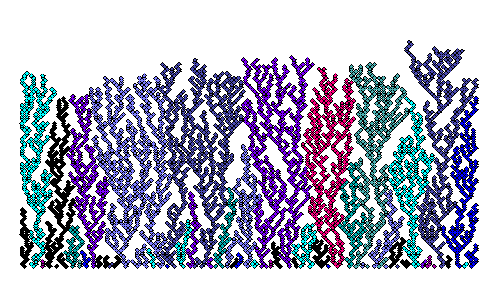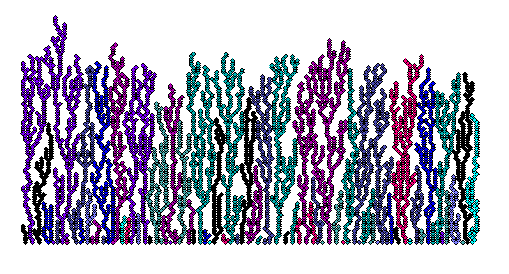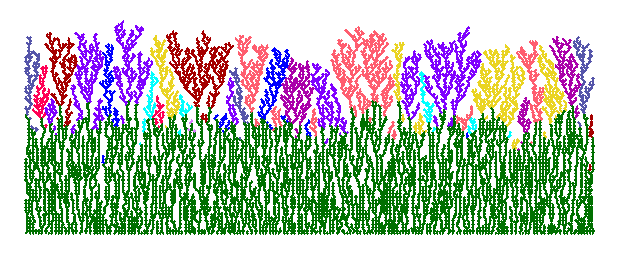Eric Weeks
- personal pages - miscWeird GrassThis is a baby form of diffusion limited aggregation. See the bottom of the page for links to other simple algorithms like this one. |
weeks@physics.emory.edu |
Eric Weeks
- personal pages - miscWeird GrassThis is a baby form of diffusion limited aggregation. See the bottom of the page for links to other simple algorithms like this one. |
weeks@physics.emory.edu |

Balls are dropped from the top of the page. They stick to the bottom of the page, or they can stick to the top of other stuck balls. This is actually easy to program, as you only need to keep track of what is at the top of each column. Balls are only dropped in columns (their coordinates are always integers). It is also easy to keep track of the color of the top ball in each column, and make the new ball the color of the ball it sticks to.
This is a baby version of diffusion limited aggregation. Click here for more information about diffusion limited aggregation.
Much to my disappointment, I discovered that other people know about
this algorithm.
HOWEVER: I do know one trick they don't mention on that page. By
slightly modifying the algorithm, you can get an affect that looks like
this:
What you do is you determine if the falling ball is sticking directly on
top of a ball, or if it's sticking on the side. If it's sticking on the
side, you have allow the program a fixed chance to try a new position.
Thus the program favors stacking balls directly on top of each other.
The result is less branching and more thin, tendril like structures
(rather than the coral looking result up above). The picture above was
generated with a retry chance of 80%.
You can combine these two effects:
This was made by setting the retry chance to 90% for the first 10000
balls, and fixing the color shown to be green. Afterwards the retry
chance was lowered to 10% and the program continued, using colors. It
makes a nice garden.
Of course, for any of this, you can always change the colors to suit
your taste.
This picture was generated using the program "grass.c" I wrote (see
below for source code) and "psdraw" for the display.
Click here for more information on psdraw.
This page created August 23, 1996.


Software
 Click here for the source code to this program.
As usual, to compile try "gcc -o grass grass.c -lm".
Click here for the source code to this program.
As usual, to compile try "gcc -o grass grass.c -lm".
![]()
Links...






Simple trigonometric plot |
Double-trigonometric contour plot |
Lissajous figures |
Simple diffusion limited aggregation |
Spiral triangles |
Polar flowers
Current address:
Eric R. Weeks
weeks@physics.emory.edu
Department of Physics
Emory University
Atlanta, GA 30322-2430